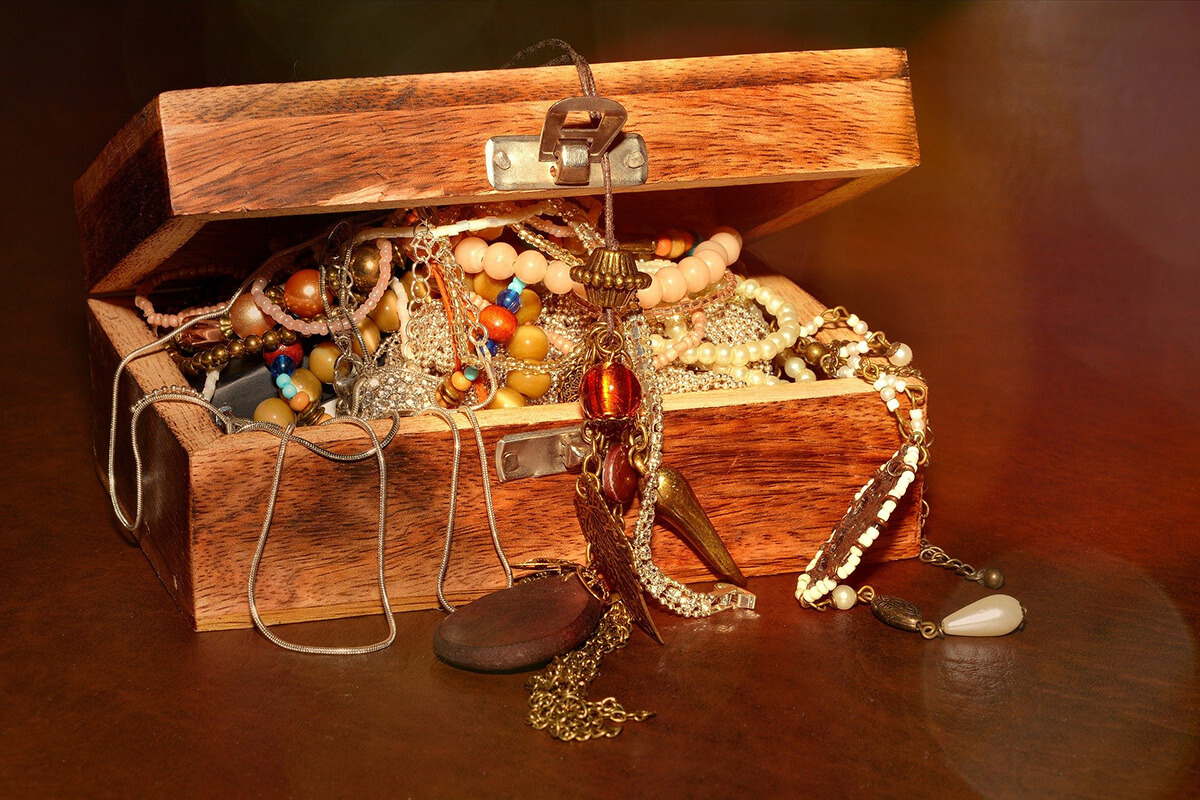
Your grandmother left you a shoe box filled with jewelry, you’ve found a piece of jewelry at a flea market, or you have a few pieces in your own jewelry box that you’re just not sure are authentic. Fashion or costume jewelry pieces are not worthless, but when you’re wanting valuable fine jewelry, how can you tell the difference between fake and the real thing?
We’ve listed several “at-home” tests for you to try, however, the safest course of action is to take your pieces to a jeweler to be tested.
Check for Hallmarks or Markings
Many metals from silver-plated to sterling silver or palladium look the same, however most valuable jewelry will have markings on them that identify the type of metal and purity. These markings are usually located on the inside of a ring or bracelet, the post of an earring, or the clasp of a necklace; if the clasp does not have a marking, chances are the piece is costume jewelry.
Sterling
- The word “Sterling” will be stamped on the piece
- The metal could be stamped with “.925”
- Some sterling silver has “925”, which means that the silver is 92.5% silver
Gold
- A number followed by the letter “k” or the word “karat” will be stamped on gold itself
- 10 karat gold may have a “.417” stamped on it
- 14 karat gold could be stamped with “.585”
- 18 karat gold might have “.750” stamped on the piece
Platinum
- The word “plat” or “platinum” will be marked on the metal
- Sterling silver with gold plating will be marked “Vermeil”
Other Jewelry Markings to Look For
- A stamp of “GF” or “HGP” indicates that the piece is gold-plated, not pure gold.
- Brand names, like Tiffany and Cartier, will have their stamp on jewelry as well
- The rings or links in the jewelry–also called the “jump rings”–will most likely be soldered together if the piece is valuable.
The appearance of markings isn’t always reliable since manufacturers are only required to provide information about the metal content and that can be done with a tag or a sales receipt after purchase. Many older pieces will be missing the markings as well. However, there are a few physical tests you can perform to tell whether it’s real or costume.
Here Is How to Test Your Jewelry
The Magnet Test
Gold and silver are not magnetic. When a piece is gold-plated, there’s metal underneath. Hold a strong magnet on your piece of jewelry. If the magnet sticks, this is an immediate indication of a fake material being used.
Most simulated gold and silver is made of brass, copper, or other base metals commonly known as “pot metal." These are not attracted to a magnet, so this test won’t work on them. Some pieces are gold-plated sterling silver and may be of value even though they are not karat gold.
Many earring posts, chain clasps, etc., are steel and will be magnetic. If a piece attracts a magnet, make sure it's not just a clasp or post. The rest of the item could be gold.
The Ceramic Test
Using an unglazed ceramic plate, drag a part of the jewelry across the surface. If it leaves a black mark on the surface of the plate, it’s not made of gold or is plated. A real gold piece of gold jewelry will show a gold streak. Be careful with this method as you run the risk of damaging your jewelry.
The Skin Test
One of the best-known ways to spot fake jewelry is the skin test. Does wearing the jewelry turn your skin green, or cause any kind of irritation? Genuine gold and silver will not react with the skin, so any problems will give away a fake piece.
The Vinegar Test
Using a dropper filled with white vinegar, place a few drops onto your metal jewelry. If the drops change the color of the metal, then it is not pure gold. If the color stays the same, then it is pure gold.
Look for Green Specks
Another obvious sign is the presence of green specks on the piece. This is corrosion of the copper or brass underlying base metal. There is no need to test anything with green specs, the item is not gold.
Fake or Costume Jewelry Won’t Have Real Stones
Once you have tested the metal, you’ll know whether the stone is possibly real or not. Jewelry that is not real gold or silver will not have real gemstones. The stones could be crystals, plastic, rhinestones or simulated gems.
Here’s something interesting: cultured pearls are considered a "gemstone." They are in the organic category, therefore they are considered fine jewelry.
How to Tell If A Diamond Is Real
The breath test is best used for determining whether a diamond is real or fake. Simply breath hot air onto the stone. A real diamond does not retain heat, so it will not fog up, while a fake diamond will. Try this same test on cubic zirconia. The surface of the CZ will continue to be foggy. This test will help you determine if you have a CZ instead of a diamond.
Get A Second Opinion
There is no way of knowing FOR SURE without a real test made by an experienced technician. We recommend taking the piece to a jeweler to be tested. They will have professional tests that will determine whether your jewelry is real as well as the purity of the metal itself. A certified appraiser will be able to provide the value of the piece as well.
Of course, buying pieces from a reputable jeweler is one way to ensure quality, high-end pieces. Jacqueline’s Fine Jewelry carries luxury collections in the Uniontown and Morgantown stores that include Roberto Coin, Charles Krypell, Lafonn, Christopher Designs, Luvente, Roman & Jules, Samuel B., Uneek, and Gabriel & Co. Visit jacquelinesfinejewelry.com for a complete list of collections and services.
